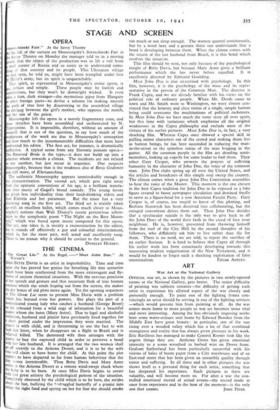• THE CINEMA
The Great Lie." At the Regal. Meet John Doe." At Warner's- '
Iss'BETTE DAVIS is an artist in improbability. Time and time gain she has proved her genius for •breathing life into scenarios hich have been synthesised from the more extravagant and fly- own of ancient theatrical situations. With the nervous precision her speech and gesture and that recurrent flash of true human notion which she -sends leaping out from the screen, she makes e dry bones of old plots move again. Yet the opening sequences I The Great Lie seem to present Miss Davis with a problem hich lies beyond even her powers. She plays the part of a ornesticated young lady who catches a husband (George Brent) his rebound from a wild orgy of infatuation for a beautiful insist whom she hates (Mary Astor). Due to legal and alcoholic usion, husband and pianist have previously lived together for short period under the impression they were married. The lanist is with child, and is threatening to use the fact to win back her lover, when he disappears on a flight to Brazil and is - eyed killed. The demented wife then arranges with the ianist to buy the expected child in order to preserve a bond th her late husband. It is arranged that the two women shall off secretly to the Arizona Desert, and it is to be the wife ho will claim to have borne the child. At this point the plot Ppears to have departed so far from human behaviour that the seems irretrievable. Then Bette Davis and Mary Astor arrive in the Arizona Desert at a remote wind-swept shack where the baby • is to be born. At once Miss Davis begins to create th her great artistry the -psychological pattern of the situation. pletely obsessed by the child which is to be hers, she strides bout the hut, bullying the t-'draggled butterfly of a pianist into eating the right food and spying on her for fear she should smoke
'too much or not sleep enough. The women quarrel continuously, but by a word here and a gesture there one understands that a bond is developing between them. When the climax comes with the return of the lost husband from Brazil, it is this bond which resolves the situation.
This film should be seen, not only because of the psychological insight of Bette Davis, but because Mary Astor gives a brilliant performance which she has never before equalled. It is excellently directed by Edmund Goulding.
- Meet John Doe is also concerned with psychology. In this film, however, it is the psychology of the mass and its repre- sentative in the person of the Common Man. The director is Frank Capra, and we are already familiar with his views on the political role of ordinary people. When Mr. Deeds came to town and Mr. Smith went to Washington, we were almost con- vinced that the honesty and clear vision of a single, simple human being could overcome the machinations of political racketeers. In Meet John Doe we have much the same story all over again, but this time with variations which emphasise all the original weaknesses in the Capra philosophy and exclude most of the virtues of his earlier pictures. Meet John Doe is, in fact, a very shocking film. Whereas Capra once showed a special skill in pulling minor characters out of the crowd and making them live as human beings, he has here succeeded in reducing the man- in-the-street to the spineless status of the man begging in the gutter. All the common people in the film are drooling senti- mentalists, looking up eagerly for some leader to fool them. They select Gary Cooper, who answers the prayers of suffering humanity in the character of John Doe, the voice of the common man. John Doe clubs spring up all over the United States, and the articles and broadcasts of this simple soul sweep the country. The climax comes when a great John Doe Convention assembles to.hear the voice of the Master. This moment is the one chosen in the best Capra tradition for John Doe to be exposed as a fake figure created to boost newspaper circulation and destined finally to serve as a figure-head for a new American Fascist Party. Gary Cooper is, of course, too stupid to know of this plotting, and Barbara Stanwyck has been deceived into collaborating, but the enraged convention drives them out. Then John Doe decides that a spectacular suicide is the only way to give back to all the John Does of the world their faith in the creed of love your neighbour. He is, however, prevented from throwing himself from the roof of the City Hall by the second thoughts of his followers, who diffidently ask him to live rather than die for them. There is no need, we are told, to repeat the sacrifice of an earlier Saviour. It is hard to believe that Capra all through his earlier work has been consciously developing towards this nauseating modern vulgarisation of the New Testament, and it would be kindest to forget such a shocking exploitation of false


























 Previous page
Previous page